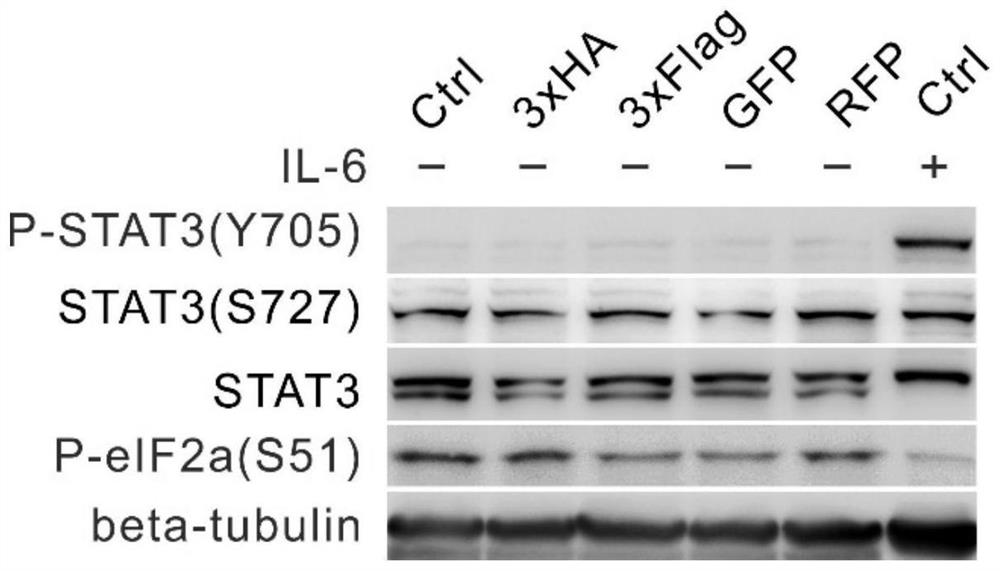Application of reagent for losing CTTNBP2NL function in preparation of medicine for treating diseases
A technology with missing functions and reagents, applied in skin diseases, bone diseases, drug combinations, etc., to reduce phosphorylation, relieve symptoms of rheumatoid arthritis, and treat rheumatoid arthritis
- Summary
- Abstract
- Description
- Claims
- Application Information
AI Technical Summary
Problems solved by technology
Method used
Image
Examples
Embodiment 1
[0056] Example 1. Overexpression of CTTNBP2NL causes increased phosphorylation of CTTNBP2NL in tumor cells
[0057] 1. Experimental method
[0058] 1. Cell culture
[0059] HEK293T, HEK293, HELA and other cells were purchased from ATCC and cultured in DMEM high-glucose medium, adding 10% fetal bovine serum and 1% penicillin and streptomycin. Cells were cultured in a cell incubator at 37°C, CO 2 The concentration is 5%. When the cell growth density was close to 90%, the cells were passaged. Use the kit to identify mycoplasma once a month to ensure that the cells are free from mycoplasma infection. The preserved cells were cultured in 75cm disposable cell culture flasks, and the remaining cells were cultured in culture dishes of different specifications.
[0060] 2. Carrier construction
[0061] (1) Extraction of cellular RNA
[0062] Use a 10cm cell culture dish to culture HEK293 cells or HELA cells. When the cell density is close to 70%, take out the culture dish, disca...
Embodiment 2
[0127] Example 2. Knockout of CTTNBP2NL causes reduction of STAT3 phosphorylation in tumor cells
[0128] 1. Experimental method
[0129] Lenti-CRISPRV2-CTTNBP2NL-guide RNA vector construction
[0130] The lentiCRISPR v2 vector was used as the eukaryotic expression vector, and the vector was purchased from Addgene. Use BsmBI of NEB Company for single enzyme digestion, enzyme digestion system: 50 μl, buffer: NEB Buffer 3.1, reaction time: 1h. Glue was recovered using the Tiangen Gel Recovery Kit.
[0131] The insert fragment is obtained by annealing into a double strand after synthesizing a single strand by the company. The annealing system: 20 μl, is carried out on a PCR machine, and the annealing conditions are: 95°C, 5min, 4°C, 5min.
[0132] The ligation was performed using T4 ligase from Quanjin Company, and the insert fragment and the digested lentiCRISPR v2 vector were ligated at a molar ratio of 7:1. Ligation conditions: overnight ligation at 16°C, and the ligation p...
Embodiment 3
[0148] Example 3. Knocking out or knocking down the expression of CTTNBP2NL in tumor cells leads to decreased cell proliferation and increased apoptosis of tumor cells
[0149] 1. Experimental method
[0150] 1. Interfering with lentiviral vector construction
[0151] (1) Synthesis of DNA fragments, annealing conditions: add 10 μl of sense strand + 10 μl of antisense strand DNA to a PCR tube, mix well, and place in a PCR machine at 95°C for 5 minutes and 4°C for 5 minutes.
[0152] The DNA sequence is:
[0153] guide RNA: ACTTTCATTGAAGAACGCTA:
[0154] Upstream: CACCG ACTTTCATTGAAGAACGCTA (SEQ ID NO.8)
[0155] Downstream: AAACTAGCGTTTCTTCAATGAAAGTC (SEQ ID NO.9)
[0156] guide RNA: GCCGCTGCCTTTCTTCCTCA:
[0157] Upstream: CACCG GCCGCTGCCTTTCTTCCTCA (SEQ ID NO. 10)
[0158] Downstream: AAACTGAGGAAGAAAGGCAGCGGCC (SEQ ID NO. 11)
[0159] guide RNA: TGTCACCTACATGCTAGAGA:
[0160] Upstream: CACCG TGTCACCTACATGCTAGAGA (SEQ ID NO.12)
[0161] Downstream: AAACTCTCTAGCATGTAGG...
PUM
 Login to View More
Login to View More Abstract
Description
Claims
Application Information
 Login to View More
Login to View More - R&D Engineer
- R&D Manager
- IP Professional
- Industry Leading Data Capabilities
- Powerful AI technology
- Patent DNA Extraction
Browse by: Latest US Patents, China's latest patents, Technical Efficacy Thesaurus, Application Domain, Technology Topic, Popular Technical Reports.
© 2024 PatSnap. All rights reserved.Legal|Privacy policy|Modern Slavery Act Transparency Statement|Sitemap|About US| Contact US: help@patsnap.com










